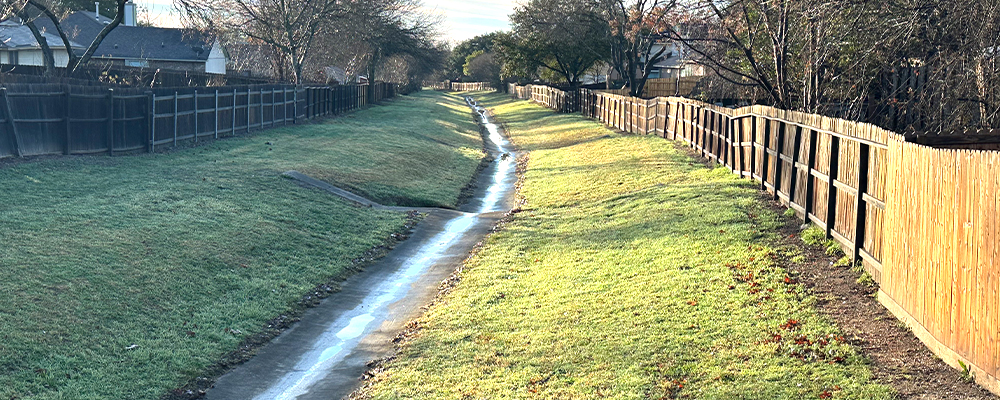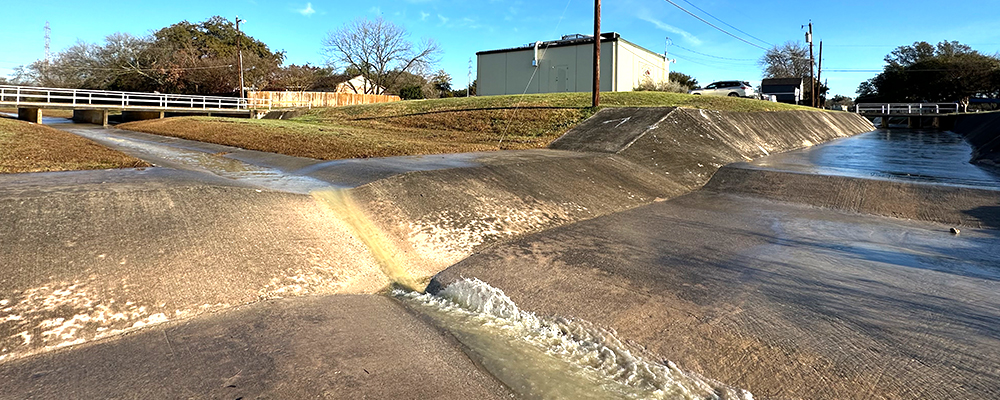Storm Water

Storm Water Management Plan
Storm Water Pollution
Effect of Sediment on Stormwater Quality
Sediment is #1 Pollutant
Erosion is the process by which water flow and wind remove soil, rock, or other material. When wind and water flows diminish, eroded materials become deposited on the ground. The material deposited is called sediment.
One of the biggest manmade sediment releases comes from construction activities. Even relatively minor home-building projects can discharge large amounts of sediment if not properly controlled. The EPA has determined that sediment is a major pollutant.
Sediment can clog storm drains and catch basins and can thereby cause flooding. When runoff carries sediment into local water bodies such as rivers, streams and lakes, it can have a negative effect on water quality, aquatic habitats and human health.
We can keep our waters clean by establishing plants, placing sod, and spreading mulch to help prevent erosion and sedimentation. It is important for stockpiles to be covered and protected from rain and wind. Sediment discharges can also be prevented by installing barriers around the perimeter of the stockpile.
In order to comply with the Clean Water Act of 1972 (as subsequently amended) and the Texas Pollutant Discharge Elimination System (TPDES) General Permit Number TXR040000, the City of Live Oak maintains a Storm Water Management Plan to help improve and protect the quality of surface, ground and storm water by reducing pollution levels in it. This is important because storm water runoff supplies drinking water sources.
To help the city achieve their goals in reducing storm water pollution, please fill out the questionnaire below. Your feedback is important to us.
Online Storm Water Questionnaire
Fact Sheet and Executive Director’s Preliminary Decision
Construction Site Storm Water Runoff Control Guidelines
Live Oak Utility Excavation Criteria Manual November 2016
Storm Water Pollution Prevention Plan Review Application
Flooding in Live Oak
Flooding in our city is caused by three sources: the West Salitrillo Creek, East Salitrillo Creek, named Tributary of Cibolo Creek. Flooding in all three areas can come with little warning.
Floods are also dangerous. Even though they appear to move slowly (three feet per second), flood waters two feet deep can knock a man off his feet and float a car. Your property may be high enough that it has not flooded recently. However, it can still be flooded in the future because the next flood could be worse. If you are in the floodplain, the odds are that someday your property will be damaged.
Live Oak has a few areas of roadway that are susceptible to flood during heavy rains, posing a threat to safety and property. Some portions of Live Oak are designated as being in a Special Flood Hazard Area (SFHA). Heavy rains in 1998 caused flooding and damage to buildings in these areas. However, your property need not be located in the SFHA to sustain flood damage. When drainage courses or storm drains become clogged, they will back up and overflow causing property damage to even upland structures.
To find out whether or not your property is in a Special Flood Hazard Area, or if you have any questions about the flood hazard in Live Oak, please contact the City of Live Oak by phone at (210) 653-9143 opt. 3 about the location of your property in relation to the flood zone and information about obtaining an Elevation Certificate. Flood maps are maintained for the City and flood safety and flood preparedness information can also be obtained. To help you learn more about the flood hazard in Live Oak, and what you can do about it, the City has available online more information to assist you in being prepared for flooding. Please learn more about Flood Insurance https://www.fema.gov/national-flood-insurance-program because homeowner's insurance policies do not cover you for flood damage. You can also learn more about what you can do to keep your life and property Floodplain and Regulations https://www.fema.gov/floodplain-management-requirements that help protect you from losses in a flood situation.
To help you get an idea of where the highest risk of flooding in Live Oak, excerpts from the National Flood Insurance Rate Map are also available online.
Resources
Bexar Regional Watershed Management https://www.brwm-tx.org
FEMA Flood Map Service Center https://msc.fema.gov/portal/home
Notice to Residents Regarding the Special Flood Hazard Area
The Special Flood Hazard Area (SFHA) is the area subject to inundation by an I00-year flood, as shown on the current Flood Insurance Rate Map (FIRM) compiled by the Federal Emergency Management Agency (FEMA).This notice is designed to make you more aware of local flood hazards, the need to keep flood insurance in force, and other topics related to flood preparedness. Please take a few minutes to review all of the items presented and determine what actions you may need to take to protect yourself.
This notice gives you some ideas of what you can do to protect yourself.
What You Can Do:
- Rake up and bag leaves as often as possible before storms. Leaves clogging storm drains are the primary source of most flood occurrences. Do not dump or throw anything into drainage ditches or streams-it is a violation of the City Ordinances. Even grass clippings and branches can accumulate and plug channels and outfall structures. Blocked drainage ways simply cannot carry water, and when it rains the water has to go somewhere. Every piece of litter contributes to flooding.
- Clean drains around your home, including roof gutters, downspouts, drain inlets, pipes. Drainage ditches and driveway culverts.
- Always check with Live Oak's Development Services (210-653-1829) before you build on, alter, regrade, or fill on your property. Permit(s) may be required to ensure that projects do not cause problems with other properties.
- If you do not have flood Insurance, talk to your insurance agent. Homeowner's insurance policies do not cover damage from floods.
- Get at least three quotes on flood insurance.
During A Flood Watch:
- Listen to the radio for news; bring outdoor belongings indoors. If time permits, move valuable possessions to the upper floors or to safe ground. Be prepared to evacuate and if advised to evacuate, do so immediately.
- Report local flooding or severe runoff to the City (210-653-9143) or Police Department (210-653-0033).
During A Flood - Flood Safety:
- Do not walk through flowing water. Drowning is the number one cause of flood deaths, mostly during flash floods. Currents can be deceptive; six inches of moving water can knock you off your feet.
- Do not drive through a flooded area. More people drown in their cars than anywhere else. Don’t drive around road barriers; the road or bridge may be washed out. Please Remember the Texas Department of Public Safety's theme. 'Turn Around. Don't Drown."
- Stay away from power lines and electrical wires. The number two flood killer after drowning is electrocution. Electrical current can travel through water. Report downed power lines to the City of Live Oak and City Public Service (210-353-4357)
- Have your electricity turned off by the City Public Service. Some appliances, such as television sets, keep electrical charges even after they have been unplugged. Don't use appliances or motors that have gotten wet unless they have been taken apart, cleaned, and dried.
- Look out for animals, especially snakes. Small animals that have been flooded out of their homes may seek shelter in places you typically wouldn't find them.
- Look before you step. After a flood, the ground and floors are covered with debris including broken bottles and nails. Floors and stairs that have been covered with mud can be very slippery.
- Be alert for gas leaks. Use a flashlight to inspect for damage. Don't smoke or use candles, lanterns, or open flames unless you know the gas has been turned off and the area has been ventilated.
For more information, contact the City of Live Oak at 210-653-9140.
Notice To Lending Institutions and Real Estate and Insurance Agents
Lending, Insurance, and Real Estate Professionals:
Re: Flood Insurance Rate Map Zone Determinations
Although the lender makes the final determination, the City of Live Oak can provide you with Flood Insurance Rate Map information useful in making flood zone determinations for any particular property within the City. As a public service, the City of Live Oak will provide you with the following information upon request:
Whether a property is in or out of the Special Flood Hazard Area as shown on the current Flood Insurance Rate Map (FIRM) of the City.
- Additional flood insurance data for a site, such as the FIRM zone and the base flood elevation or depth, if shown on the FIRM.
- Copy of completed Elevation Certificates and Letters of Map Revision (LOMR) information if available.
- A handout on the mandatory purchase of flood insurance requirements to assist people who need a mortgage or loan for a property in the Special Flood Hazard Area.
When contacting the City to obtain flood zone information, please be prepared to provide the street address. You may call the City Monday through Friday, 8 a.m. to 5 p.m. for assistance. Request Flood Insurance Rate Macs from FEMA (Federal Emergency Management Agency) by calling 1-800-358-9616, or visit the FEMA Map Center Service at https://www.fema.gov/flood-insurance-rate-map-firm
If you have any questions or inquiries regarding the City's Floodplain Management Program, please feel free to contact the City at 210-653-9143 opt.3.
The City of Live Oak
ATTN: Floodplain Manager
8001 Shin Oak
Live Oak, Texas
Flood Insurance
Homeowner's insurance policies do not cover damage from floods, so if there is a possibility that your belongings may be flooded, flood insurance must be purchased to cover this eventuality. The City of Live Oak participates in the National Flood Insurance Program (NFIP), administered by The Federal Emergency Management Agency (FEMA). Live Oak's participation makes available federally backed and reasonably priced insurance available to its citizens. All properties in the Special Flood Hazard Area (SFHA) are required to purchase flood insurance. Since 25% of flood damage occurs in properties not in a high-risk zone, it may also be a good idea to purchase flood insurance even if you are not in a SFHA. The National Flood Insurance Program (NFIP) offers federally backed flood insurance in communities that comply with the minimum standards for floodplain management. The NFIP imposes a 30-day waiting period after the purchase of flood insurance, so it is important to purchase flood insurance before the beginning of the rainy season to protect your home in the event of a flood. NFIP policies can also help provide funding to assist bringing structures into current building standards to reduce the risk of flood damage.
Live Oak's participation in the NFIP is determined by the City's work in managing its floodplain in ways that meet or exceed standards set by FEMA. When communities go beyond the minimum standards for floodplain management, the NFIP's Community Rating System (CRS) provides discounts off flood insurance premiums for policyholders in that community.
To get more specific information about Flood Insurance, go to FloodSmart.gov: Insurance Center https://www.floodsmart.gov/flood-insurance/why or FEMA's National Flood Insurance Program https://www.fema.gov/national-flood-insurance-program
There are now 1500 communities receiving flood insurance premium discounts based on their implementation of local mitigation, outreach, and educational activities that go well beyond minimum NFIP requirements. While premium discounts are one of the benefits of participation in CRS, it is more important that these communities are carrying out activities that save lives and reduce property damage. These 1500 communities represent a significant portion of the Nation's flood risk as evidenced by the fact that over 67% of the NFIP's policy base is in these communities. Communities receiving premium discounts through the CRS cover a full range of sizes from small to large, and a broad mixture of flood risks including coastal and riverine. See Community Rating System (CRS) Brochure https://www.fema.gov/sites/default/files/documents/fema_community-rating-system_local-guide-flood-insurance-2018.pdf for more information.
Floodplain Understanding and Regulations
Maintaining safety and preventing flood damage in the City of Live Oak requires that the government and the residents work together to keep the city prepared for a flood.
Do not dump or throw anything into drainage ditches or streams: it is a violation of our City's ordinances and can be a source of flood occurrences in Live Oak. Even grass clippings and branches can accumulate and plug channels and outfall structures. Blocked drainage ways simply cannot carry water, and when it rains the water has to go somewhere. Every piece of litter contributes to flooding. It also helps to clean drains around your home, including roof gutters, downspouts, drain inlets, pipes, drainage ditches and driveway culverts. If you discover a drainage course that is not functioning properly, please contact the City of Live Oak at 210-653-9143, opt 3.
Please obtain permits before building: development in the City of Live Oak is carefully regulated and any construction that takes place, inside or outside the building, requires permits from the City. In the Special Flood Hazard Areas, special rules apply that require new developments be protected from flood damage, elevating the structure's lowest level above the base flood elevation. They must also be anchored to prevent lateral movement in the case of flooding. These rules also apply to any substantial improvements to buildings or repairs to any substantially damaged buildings. A substantial improvement is defined as an improvement or repair worth 50% of the original building's value. If you have any questions about permits or whether you need permits, call the City's building department at 210-653-1829
Recognize the natural and beneficial functions of floodplains: Although the Special Flood Hazard Area in Live Oak covers over only a small portion of the City, many of those acres are preserved as natural open space areas. Understanding and preserving these areas provides many benefits to the city, including flood protection. These areas spread out floodwater, reducing their velocity and thus erosion damage, as well as collecting silt and sediments from upstream. They also act as a non-damaging location for floodwater to drain to, thus reducing property damage. Furthermore, these areas add to the beauty of our town and give an opportunity for wildlife to grow for mutual benefit.
What You Can Do
Floods can happen suddenly. The most important part of flood safety is to prepare before the floods happen. It is too late to learn and prepare when the disaster has already struck.
Before a flood:
- If you do not have Flood Insurance, talk to your insurance agent.
- To prevent significant flood damage to your building, you can retrofit it. Retrofitting can take the form of flood proofing the lower portions of the house or elevating the house above the base flood elevation. For more information about retrofitting, look at the resources at FEMA's online library, or the Universal City Public Library. You can also contact the Public Works Department at 210-653-9143, opt 3 for more guidance on this issue.
- Rake up and bag leaves as often as possible before storms. Leaves clogging storm drains are the primary source of most flood occurrences.
- Clean drains around your home, including roof gutters, downspouts, drain inlets, pipes, drainage ditches and driveway culverts.
- During a flood watch, tune in to local television or radio for news.
- Bring outdoor belongings indoors, and if time permits, move valuable possessions to the upper floors of your home. Use sandbags as a temporary measure to help reduce flood damage to your home. Call the Police Department (210-653-0033) or 911 for immediate assistance.
- Be prepared to evacuate, and don't hesitate to evacuate if so advised.
- Report local flooding or severe runoff to the Public Works Department (210-653-9143) or the Police Department (210-653-0033).
During a flood:
- During a flood, tune in to KKYX radio station, 680 AM. This station will broadcast emergency information in the event of flooding or other citywide emergencies.
- To report flooding, call Public Works: 210-653-9143, or the Police Department: 210-653-0033.
- Do not walk through flowing water; 6 inches of moving floodwater can knock you off your feet.
- If you are in a car, do not drive through flooded areas. A mere two feet of moving floodwater can drag vehicles away, and as little as six inches of water will short out most cars.
- Be careful of downed power lines and displaced animals in the water, especially rattlesnakes & rats.
- Watch your step for debris underfoot, like broken glass.
- Always use flashlights to inspect areas, never matches or open flames because of the potential for gas leaks.


Public Works
8001 Shin Oak Drive
Live Oak TX 78233
(210) 653-9143
mypw@liveoaktx.net
City Core Values
Integrity
Trust and faith to do what is best for our team and community.
Accountability
Responsible for our words, our actions, and our results.
Teamwork
Together we will achieve the greatest results.
Leadership
The courage to rise above challenges, work through adversity, and inspire others.
Loyalty
Dedication to the mission, the community, and each other.
